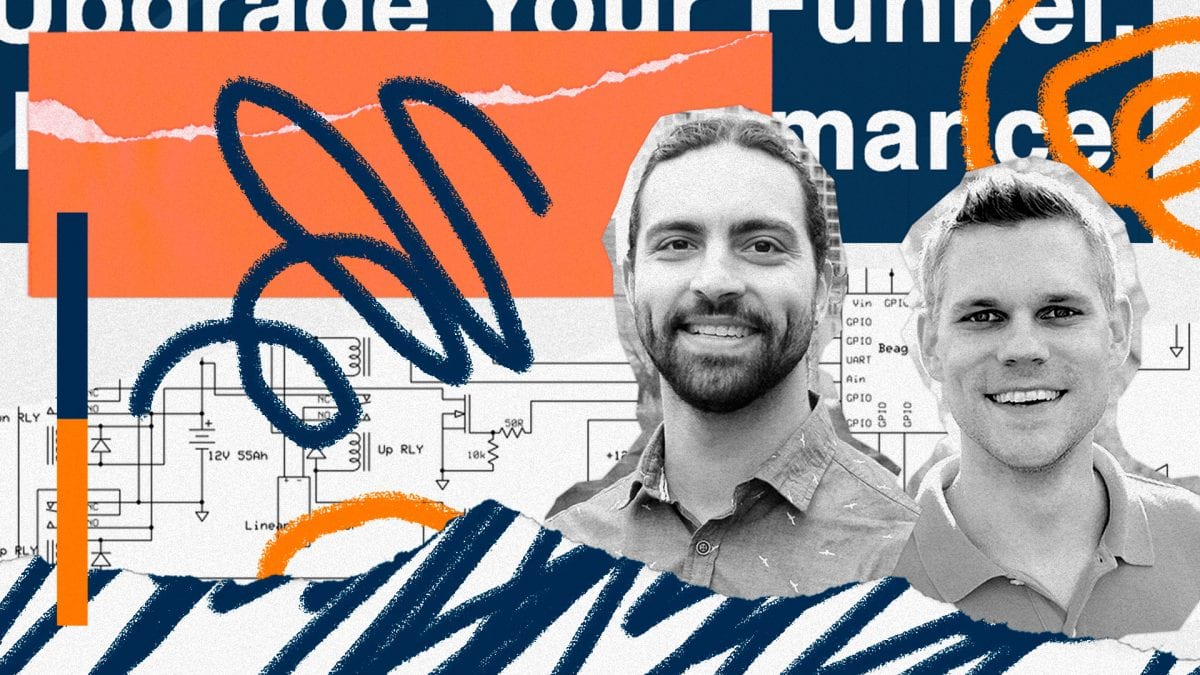Running an agency is difficult. Running a successful one, even more difficult.
That’s very true.
What’s also very true is that agencies have on their ranks some of the most efficient marketing minds in the world.
Coming from an agency ourselves, Savvas and I try to keep a close eye on what’s going on in the agency terrain.
Since we launched Messenger Bot Giveaways by Viral Loops we are in a constant search for people that really know how to use Messenger bots.
Every once in a while, we come across a brilliant mind and- surprise, surprise, they either work for or own an agency.
After our insightful interviews with Arri Bagah and Hunter McKinley, we got in touch with the amazing Samir ElKamouny & Matt Lampkin from Fetch & Funnel. We scheduled the interview, and Savvas had an amazing conversation with them.
Here’s what they had to share with us.
What is Fetch & Funnel?
Fetch & Funnel is an acquisition agency. We specialize in helping e-commerce brands to scale sales and revenue–primarily through social advertising and sales funnels.
We’ve also been designing, testing and integrating Messenger as a channel into our social strategies for almost two years now.
We found Facebook Messenger to be one of the best ways for a brand to acquire customers, because it’s an incredibly powerful way to solve problems throughout your marketing funnel.
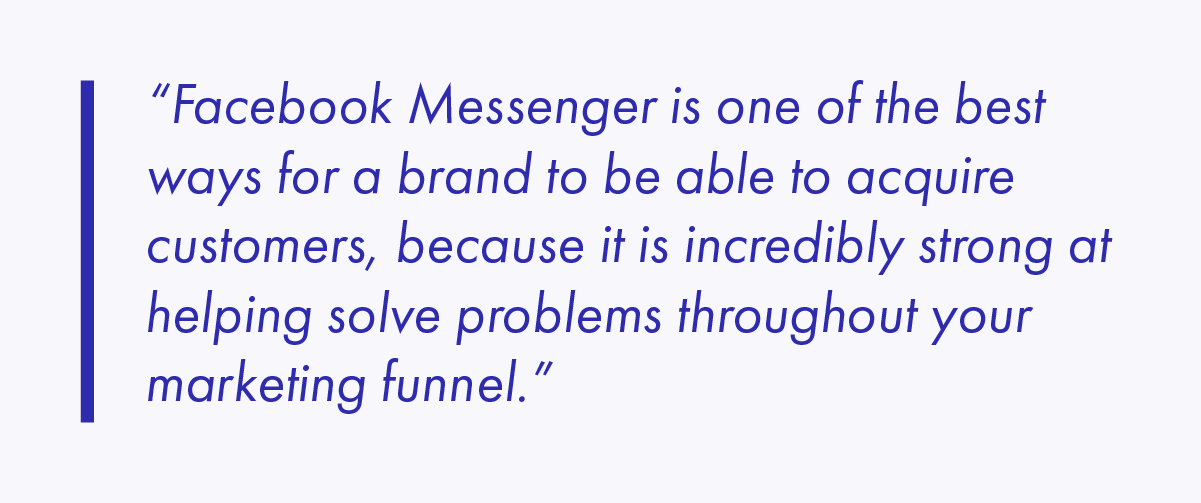
How did you decide to integrate messenger marketing into your clients’ strategy?
We still do Facebook advertising the way we were doing it before Messenger, but the second we saw that you could build a subscriber base on Messenger, our first thought was that this is going to be the next biggest marketing channel.
It was just super obvious, all we had to do was to figure out how to utilize it.
What are the best practices?
What are the tactics and strategies that will work?
Then we just ran from there.
Combining Email with Messenger Marketing.
Email’s not dead. It’s just another way to market your audience.
You can write a long paragraph in an email, but you can’t write a long paragraph in Messenger.
They’re two different channels, and two channels are better than one. You can get the same message in front of your audience in more than one place.
Messenger is a little bit less intrusive, and combining the two is a really, really great way to to get email addresses for a much lower cost.
You can get email address directly in Messenger.
For example, we found out that the most inexpensive way to gather registrations for a webinar was to ran a Facebook ad to a messenger bot that asks for their email address and it automatically registered them to a webinar.
Email’s not dead.
It was the lowest cost for webinar registrations, plus we could get people in both email and Messenger channels and then play to the strengths of each.
From an email list to Messenger.
If a client already has an email list, there’s an opportunity to transfer people to Messenger and start to market to them according to the needs of the platform.
It seems like it should be easy to ask people to subscribe to your Messenger list. Just send an email to everyone and ask them to sign up. Right?
The problem with that is there’s no incentive, there’s no bait and you’re also not taking advantage of segmentation.
If you have a large email list and you’re a good email marketer, then you’ve already done some advanced segmentation. Therefore, you should be segmenting your Messenger list the same way and then adapting your content to the medium.
Don’t send the same message to both prospects and customers. Do customize your messages for each audience and then be sure to add tremendous value that appeals to each audience.
When speaking to prospects you should say, “hey, here’s a link to get answers to our most frequently asked questions” OR, “Let us help you customize the perfect product for you”.
Keep it simple when trying to add value. A simple coupon can go a long way.
Adding value, giving some sort of bait to get them to click and subscribe on Messenger, is definitely be the most important thing.
After that, you should segment them as well, which is really easy to do.
You could be subscribing people to different bots or to a different sequence, and once they’re in you can nurture.
If your email list is not segmented, this is the perfect opportunity to get them into Messenger, and ask a couple qualifying questions and segment your audiences from there.
We found that on an email list it’s pretty common that, unless somebody is a paying customer, you don’t have much information about them, to begin with. You don’t really know their preferences. You don’t know what their interests are. If you sell different products or you offer different services, or have different types of content you’re probably not exactly sure how to match up potential customers with the right offers.
You don’t know why they signed up in the first place, and what information or material resonates with them. In Messenger, you can just go and ask them, so that they’ll tell you what they’re most interested in. At this point you’ll able to segment and personalize right, for extremely relevant marketing.
⚡Note from Savvas:
A lot of people (especially in eCommerce) segment their Messenger list by having a menu inside Messenger, or they have a link somewhere on their website to get product suggestions. It’s something like a quiz asking their users some questions in order to suggest them the best products for them.
This is a great way to gather, with two or three questions, data about your subscribers and segment them.
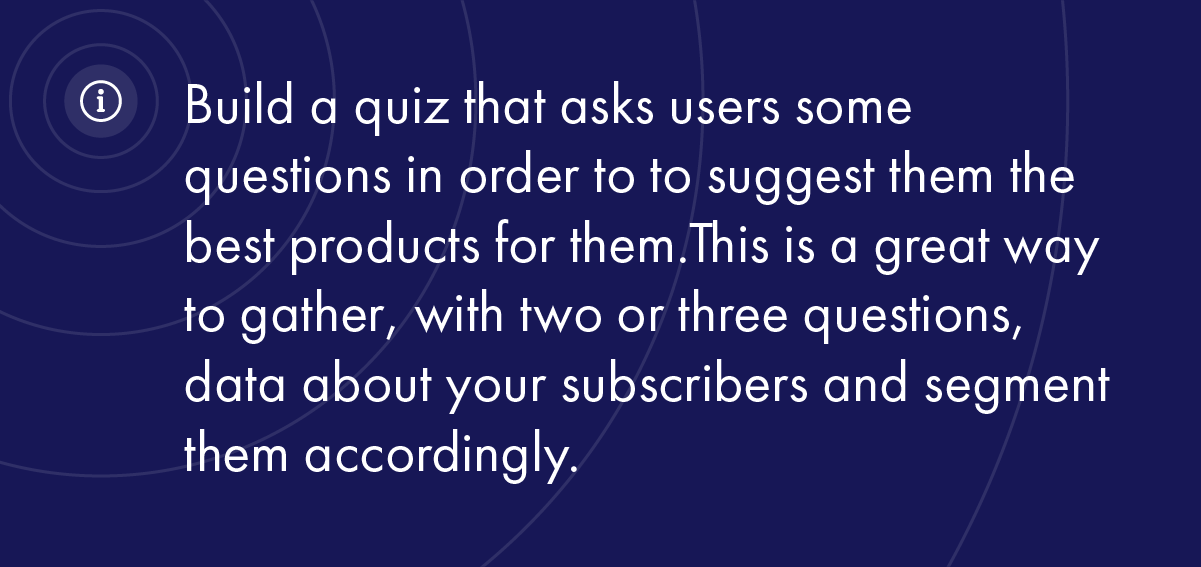
Asking the right questions to segment your Messenger list.
You need to ask your subscribers questions, and then you can add a tag to each answer they give you.
I think the more tagging you do, the better. At least up to a certain point. If you’ve got a thousand tags that you’re never going to take advantage of, that sort of doesn’t help.
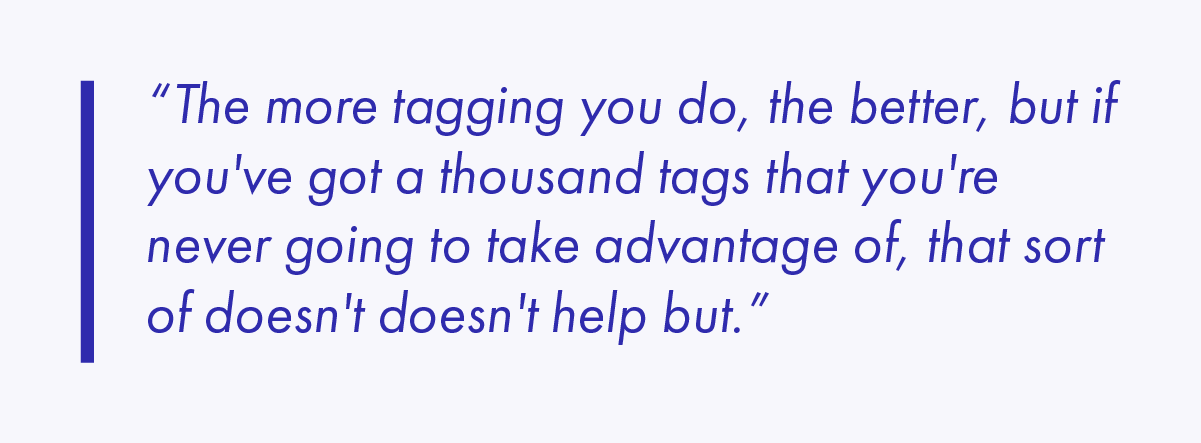
If you do a product recommendation based off of either their preferences or their interests, it’s really a hundred times more powerful than just having a follow-up message.
You can offer a discount on their preferred product, or give info for a new version of that product.
With a simple question about their preferences, you have now segmented that person and by their interest and now you can literally offer them the exact product that they want.
Ask people questions that show your their interests/preferences/tastes.
How often should we broadcast to our Messenger subscribers?
There’s no golden rule in that. It really depends on the brand.
I would say the biggest thing is really keeping an eye on metrics like your Open and Click-Through Rates.
If you’re sending a message every single day and you’re not adding that much value, you will immediately see those phenomenal 80% open rates, and 30% click-through rates start to decline.
That’s really a great way to see how if you’re (a) messaging too often and (b) not adding value. I’ll say it again:
The most important thing is adding value.
Maybe you’re nurturing someone about what your mission is, or why they should be interested in working with you, or about why your products are the best in the market, but that’s still sort of salesy.
So you should add some value to their life by, for example, sending them a blog post that is slightly related to your business, but not trying to sell them.
If all you’re trying to do is sell someone over and over again, that’s really where you’re going to get the unsubscribes, and a huge decline in Open and Click-Through rates.
Don’t forget to make sure it’s easy to unsubscribe.
If you don’t, people will go and mark you as spam, and if that happens too often, Facebook will suspend you from being able to send broadcasts or messages.
It’s super important to make that explicitly clear.
We find with most of our clients, broadcasting once a week is great. If we’re adding value and getting great results we’ll increase frequency.

Another thing to keep in mind is that if you built sequences and you have a bunch of people in them, make sure that you’re not sending a broadcast super-close to when you may have scheduled a sequence to be sent to them.
Just make sure that you’re not imposing on anybody at all.
It’s important to create a schedule for your broadcasts and your publishing– just like you might create a monthly email calendar so that you adapt at the frequency of sending broadcasts based upon the data that comes back.
A great example of this is one of our clients, they’re called the Gadget Flow and they’re one of the largest platforms of essentially promoting different products and different gadgets. They don’t directly sell them, but they have thousands and thousands of products on websites like Pinterest.
We quickly built them a large subscriber list, and we started sending broadcasts out. We were sending them very frequently, maybe two or three times a week.
Then we noticed that the Open rates Click-Through rates were really steadily declining and we couldn’t figure out why.
And so we realized that we weren’t speaking to our audience in the correct way.
What we’ve done since then is that we completely segmented the current audience and then anybody who joins by asking questions like “Hey, what type of gadgets are you interested in?”, “Is kitchen gadgets?”, “Is it travel gadgets?”
We went and ask them a bunch of different questions about exactly which categories they’re interested in. Now we send out a blast every Friday and that is specifically tailored to only tell them about the coolest gadgets in the categories that they specified that theywant to know about.
That kept the Open the Click-Through Rates extremely consistent.
Successful Messenger flows for e-Commerce stores.
Giveaways are extremely powerful if you keep it consistent with your product offering.
They are extremely powerful and you can do some really interesting things woth them, like running a Facebook ad about the giveaway and asking people to enter to win.
You can definitely have them to do something extra in order to register; e.g. follow you on Instagram, give you their email address etc. Then you can ask them one or two qualifying questions, like which product they’re interested in. That way, you’ll be able to segment them.
After the giveaway is over, maybe a week later, you can tell everybody, “The winner has been announced on our Facebook page. You can go check it out. If you were the winner, you’ve already been messaged, but because we had so much interest and buzz around this we’d like to pick some runner-ups. Would you like to see if you’re a runner-up?”
Now, the secret is everybody’s a runner-up. Then you give them a coupon code to the exact item that they said they’re interested in.
This works extremely well, but you can’t do it all the time, because otherwise, people are going to catch on if you’re not segmenting only to new people.
Your old list is going to be like hey, “I’m always a runner up. What’s up with that?”
So you can also build some evergreen versions of this; it could be a super similar model where it’s not really a giveaway but it’s a quiz or a test or whatever you want to do.
You can gamify it and make it really fun and allow them to win.
We’ve done this for some really big brands and it works really really well.
Everybody loves to play a game, and it’s quick and easy to just click the buttons in Messenger. Plus by providing them that coupon code, they feel like they won something.
It definitely works really really well, but again- it’s super important to ask them what they’re interested in and then give them a coupon code just on that item, or maybe put together a bundle that includes that item.
We’ve had really really great success with that as well.
This is a great way to increase your average order value, but also give them the thing that they were interested in at a discount.
You can do this in a lot of different ways. You could do a giveaway for a product launch.
We work a lot with crowdfunding campaigns like Kickstarter and IndieGoGo, and you can use this tactic to build a massive list before you launch your crowdfunding campaign.
Boulding the pre-campaign list building is probably more important than the actual campaign itself because it determines how much success you’re going to have when you launch your Kickstarter or Indiegogo.
Giveaways are a great way to build your list, but don’t stop there…give everybody a coupon code or a special offer the minute you launch.
List building and giveaways are also a powerful way to maximize Black Friday. Your competitors are going to spend their advertising dollars in a very short window, it’s uber-competitive.
If you have an internal support team within Facebook, or you work with an agency like us, where you can tell Facebook “hey I’m planning to spend this much make sure I have enough ad buying space.”, If you don’t have that connection or partner manager, you probably won’t even be able to spend your budget.
So here’s what you can do instead. In the weeks before it gets super competitive, run a giveaway on Viral Loops and build a massive list for cheap. Even if you’re losing money, it’s totally okay because the second Black Friday happens, just run heavy retargeting and blast your messenger list for free.
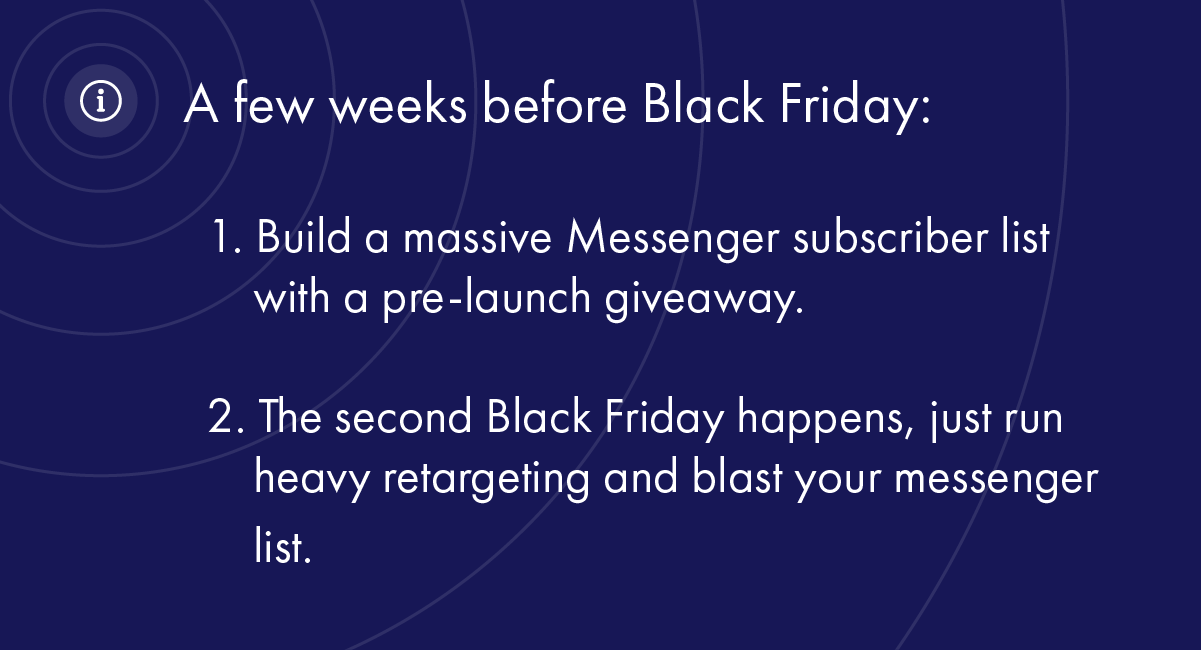
That worked extremely well for us this past year. It’s also a lot of fun because the sales come flying in after a well-coordinated Messenger blast.
It’s also not like your new subscribers aren’t going to hear from you for two or three weeks. Nurture them along the way. It’s incredibly powerful if you can ask a consumer what it is that they’re actually interested in.
The power of Messenger is that your message gets through. You’re not going into the Gmail promotions tab with every other competitor. Your message will be read, and if there’s value you’ll see fantastic results.
The power of Messenger is that your message gets through.
And as long as you’re able to sort of qualify upfront and determine what users are actually interested in — to send out the right offer at the right time, you don’t have to rely on advertising to get in front of that person to get that sale.
You could do it for any sort of product launch, any sort of giveaway, promotion, or offer.
⚡Note from Savvas:
Something that I’ve seen from one of our clients is that they run a wishlist giveaway.
So, they say that five people will win their wish list up to $300 each, and they ask people on messenger to add their favorite products, so somehow to create a wish list and if they win they will get these products.
So everybody that joins the giveaway completes the wish list.
Basically, they built and segmented their list at the same time. That way they knew what products are for which people and start selling according to the segmentation.
Fetch & Funnel’s favorite chatbot platforms.
We’re sort of platform agnostic, so I would say the top three that we use are ChatFuel, Mobile Monkey and Manychat.
I think each one of them has some different Pros.
There are other Bots that can be very tool specific. Like there’s a lot of great Shopify cart abandonmet plugins, but again, they solve one specific problem.
Manychat has a lot of different uses, like website pop-ups, scan codes, comment tools, etc.
Mobile Monkey allows split testing, which is nice because you can set up some conversions inside the platform and track them. It’s almost like setting up goals in Google Analytics. You set a goal inside Mobile Monkey and you can track those conversions.
ChatFuel has a very open JSON API where you can send data back and forth between virtually anything. It’s a great way to run abandoned cart sequences, for example.
We will run a Facebook ad to “cart abandoners”, get them into a messenger bot, offer them some sort of value to make that purchase, and we can grab their email address associate their Messenger ID and their email.
We send the data to CRM via Zapier. Then when a purchase is made on the website, we send a broadcast through the API back to ChatFuel.
After this happens we exclude them from the abandoned cart sequence and they automatically get moved over to the customer list.
Another thing that I think is really, really important- that most people overlook, is reporting.
ChatFuel has pretty decent reporting. Manychat also has decent reporting. But you can get way more advanced by utilizing a tool like Dashbot. With Dashbot you can track what your top messages are, as well as the performance of every step in your bot funnel.
Platform selection comes down what you’re trying to accomplish. We’ve even got one client using three different platforms.
Testing your campaigns is crucial.
You can’t just try one thing and then give up on it if it doesn’t really work well.
You really have to test different messages and different outcomes. If you made it sort of long, make it simpler. Do different testing of different bots, because it’s just like a website.
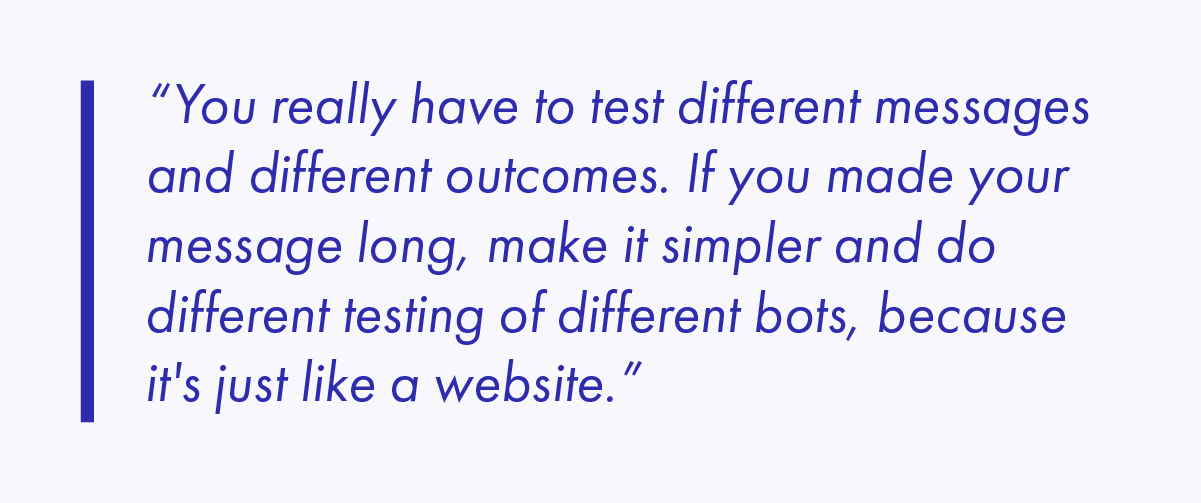
It’s just like a funnel. It’s just like anything, really in marketing.
You will eventually find one that will really unlock a high ROI, but it might not be the first one, and it might not be the one that you thought was the clear winner, or the best one, or the most unique one.
For example, we did a huge giveaway with a client. They were giving away three $700 phones.
You would think that everyone’s going to sign up for this thing immediately, but it was a phone that no one had ever heard of.
So we told the client: “hey if you’re giving away three of these phones, it would be better if we just gave away one iPad or are two Samsung Galaxy phones or whatever because people will recognize that and be more likely to sign up”.
Even though they were giving these super awesome expensive phones, people din’t care what the specs are if they don’t really recognize the brand.
It’s definitely important to test different things.
Don’t forget to spread the word.
Something else that we see quite a lot is that people launch their campaigns and then they don’t spend time on letting their people know about it. The campaign doesn’t perform, and they are left wondering what went wrong, and why their ROI is negative.
They expect to see results based on the fact that they’re paying for it.
You don’t really have to “shout” to get people’s attention.
Build a unique experience and let people know about it.

You can look at Tony Robbins’ bot, Timothy Sykes’ bot. You can look at Gadget Flows’ bot, or even Product Hunt’s bot, and see that right when you enter it’s a unique experience and you get to mess around with it for a few minutes.
It provides value, and It’s asking questions. You can’t lose when you create an experience like that.
You should link your bot with all of your digital assets.
Put it on your website, in your email signatures, on your Instagram account.
Build that subscriber base, because it is never going to be as cheap as it is today to build your Messenger list. And so it’s so important to do it as fast as possible because, in two years from now, you’re just going to totally regret that you didn’t do it.
All your competitors are going to be doing it, and you don’t want to be late in the game when you can really be so early right now.
Apostle Mengoulis
Apostle is a core member of the founding team at Viral Loops. He has worked closely with hundreds of referral marketing campaigns made with Viral Loops. Apostle has years of experience in growing and marketing companies and co-founded Growth Hacking University.
